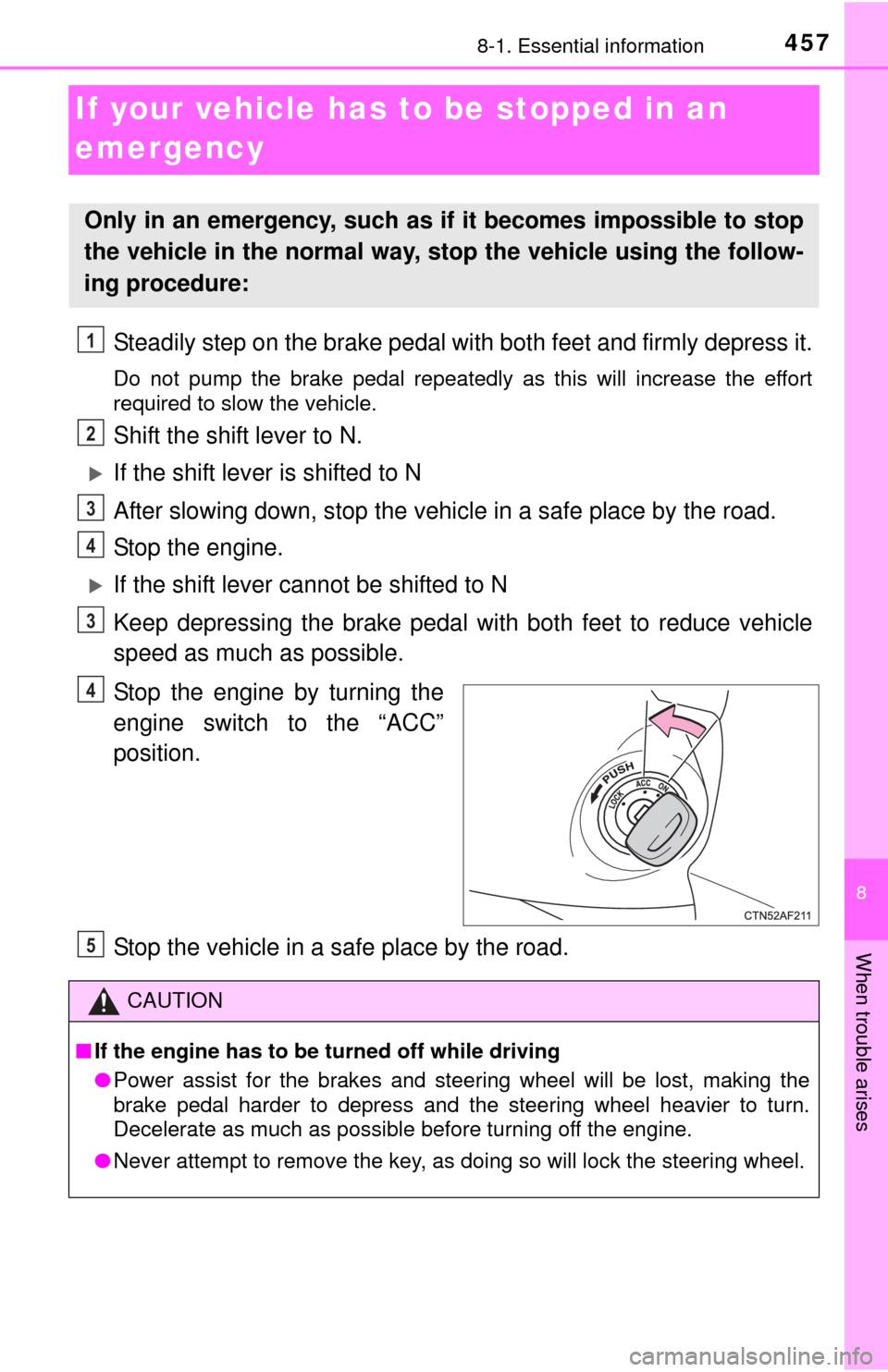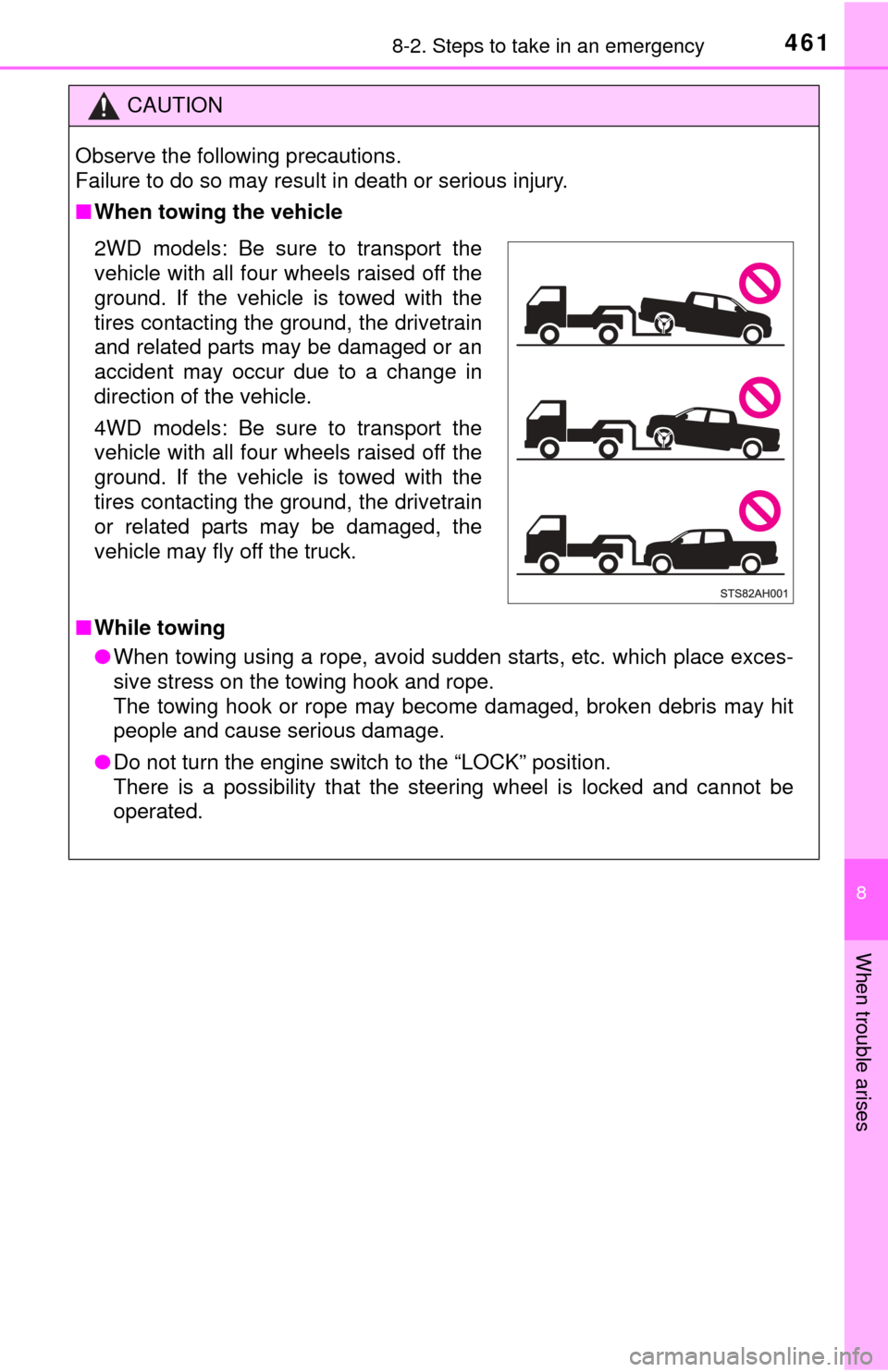Page 430 of 576
4307-3. Do-it-yourself maintenance
Air conditioning filter
Turn the engine switch off.
Open the glove box.
Remove the tray.
Remove the cover by sliding up
while pulling toward you.
The air conditioning filter must be changed regularly to maintain
air conditioning efficiency.
Removal method
1
2
3
4
Page 435 of 576
4357-3. Do-it-yourself maintenance
7
Maintenance and care
Checking and replacing fuses
Turn the engine switch off.
Open the fuse box cover.
Engine compartment
Push the tab in and lift the
cover off.
Under the instrument panel
Remove the cover.
Remove the fuse with the pull-
out tool.
Only type A fuse can be removed
using the pullout tool.
If any of the electrical components do not operate, a fuse may
have blown. If this happens, check and replace the fuses as nec-
essary.
1
2
3
Page 455 of 576
455
8When trouble arises
8-1. Essential informationEmergency flashers .......... 456
If your vehicle has to be stopped in
an emergency ................. 457 8-2. Steps to take in an emergency
If your vehicle needs to be towed ......................... 458
If you think something is wrong .............................. 463
Fuel pump shut off system ............................ 464
If a warning light turns on or a warning buzzer
sounds ............................ 465
If a warning message is displayed......................... 472
If you have a flat tire.......... 476
If the engine will not start ................................. 491
If the shift lever cannot be shifted from P............. 492
If the vehicle battery is discharged ...................... 494
If your vehicle overheats ... 497
If the vehicle becomes stuck ............................... 499
Page 456 of 576
4568-1. Essential information
Emergency flashers
Press the switch.
All the turn signal lights will flash.
To turn them off, press the switch
once again.
■Emergency flashers
If the emergency flashers are used for a long time while the engine is not
operating, the battery may discharge.
The emergency flashers are used to warn other drivers when the
vehicle has to be stopped in th e road due to a breakdown, etc.
Page 457 of 576

457
8
When trouble arises
8-1. Essential information
If your vehicle has to be stopped in an
emergency
Steadily step on the brake pedal wi th both feet and firmly depress it.
Do not pump the brake pedal repeatedly as this will increase the effort
required to slow the vehicle.
Shift the shift lever to N.
If the shift lever is shifted to N
After slowing down, stop the vehicle in a safe place by the road.
Stop the engine.
If the shift lever cannot be shifted to N
Keep depressing the brake pedal with both feet to reduce vehicle
speed as much as possible.
Stop the engine by turning the
engine switch to the “ACC”
position.
Stop the vehicle in a safe place by the road.
Only in an emergency, such as if it becomes impossible to stop
the vehicle in the normal way, st op the vehicle using the follow-
ing procedure:
1
2
3
4
3
4
CAUTION
■ If the engine has to be turned off while driving
● Power assist for the brakes and steering wheel will be lost, making the
brake pedal harder to depress and the steering wheel heavier to turn.
Decelerate as much as possible before turning off the engine.
● Never attempt to remove the key, as doing so will lock the steering wheel.
5
Page 458 of 576
4588-2. Steps to take in an emergency
If your vehicle needs to be towed
The following may indicate a problem with your transmission. Contact
your Toyota dealer or commercial towing service before towing.
●The engine is running but the vehicle will not move.
● The vehicle makes an abnormal sound.
Do not tow with a sling-type truck
to prevent body damage.
From the front
Use a towing dolly under the rear
wheels.
If towing is necessary, we re commend having your vehicle
towed by your Toyota dealer or commercial towing service,
using a lift-type truc k or flatbed truck.
Use a safety chain system for all towing, and abide by all state/
provincial and local laws.
Situations needs to contact dealers before towing
Towing with a sling-type truck
Towing with a wheel-lift type truck
Page 460 of 576
4608-2. Steps to take in an emergency
If a tow truck is not available in an emergency, your vehicle may be
temporarily towed using a cable or chain secured to the emergency
towing eyelets. This should only be attempted on hard surfaced roads
for short distances at low speeds.
A driver must be in the vehicle to steer and operate the brakes. The
vehicle’s wheels, drive train, axles, steering and brakes must be in
good condition.
Securely attach a cable or chain to the towing eyelet.
Take care not to damage the vehicle body.
Enter the vehicle being towed and start the engine.
If the engine does not start, turn the engine switch to the “ON” position.
4WD models: Put the front-wheel drive control switch in “2WD”.
Shift the shift lever to N and release the parking brake.
When the shift lever cannot be shifted: ( P. 492)
Emergency towing
Emergency towing procedure
1
2
3
4
Page 461 of 576

4618-2. Steps to take in an emergency
8
When trouble arises
CAUTION
Observe the following precautions.
Failure to do so may result in death or serious injury.
■When towing the vehicle
2WD models: Be sure to transport the
vehicle with all four wheels raised off the
ground. If the vehicle is towed with the
tires contacting the ground, the drivetrain
and related parts may be damaged or an
accident may occur due to a change in
direction of the vehicle.
4WD models: Be sure to transport the
vehicle with all four wheels raised off the
ground. If the vehicle is towed with the
tires contacting the ground, the drivetrain
or related parts may be damaged, the
vehicle may fly off the truck.
■ While towing
● When towing using a rope, avoid sudden starts, etc. which place exces-
sive stress on the towing hook and rope.
The towing hook or rope may become damaged, broken debris may hit
people and cause serious damage.
● Do not turn the engine switch to the “LOCK” position.
There is a possibility that the steering wheel is locked and cannot be
operated.